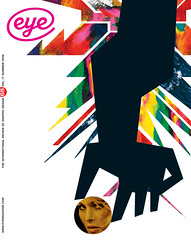Summer 2008
Adam + Sébastien
Who cares about graphic design history?
Adam Machácek is from Prague, in the Czech Republic, where he competed a Masters at the Academy of Arts, Architecture and Design in 2004 (though he did ‘half his studies abroad’). Sébastien Bohner is from Lausanne, and studied at Ravensbourne College of Design and Communication in the UK, where he graduated in 2002.
Q1. What do you think is meant by ‘the canon of graphic design history’? For example: The Bauhaus? Beck’s Underground diagram, etc., etc. Do you ever think about it, or buy design history publications?
A1. We are aware of all the examples you’ve mentioned and we keep a great respect for these works. But we’ve never thought of it as of a canon. For us, they are part of our memory, some are our ‘heroes’, just like great movies, music or books. Once we got to know them, they are there, somewhere in our heads, and therefore we must be influenced by it. Sometimes they pop up – it’s often because of an exhibition or a book.
Sometimes we buy a new monograph, and we certainly go to see exhibitions, but it happens only a few times a year.
Q2. Does this kind of design history have relevance to your practice?
A2. It must have, even without noticing it directly. You do something, you see it and suddenly you think, hey, it looks like from the 1960s! You see a text set in lowercase and you think Bauhaus. So this design history is there in our heads, but when we work, we are not trying to do something that looks like Bauhaus or Swiss Modernism. Our work looks like our client. We are like journalists, just visual.
For example, we were working on an exhibition catalogue on rock music and its impact on visual culture of the 1960s. Our studio playlist quite changed in that period and we’ve been listening to psychedelic rock. We spent hours with the author of the exhibition – touching, smelling and selecting all exhibits to be reproduced in the catalogue: posters, LP covers, books, magazines, objects. Being in his house surrounded by his never-ending collection, that felt like being in magic library to us. With a magic librarian, of course, because the curator lived his youth in the 1960s and knew everything about it. And we think he chose us to design the publication because we are young now. He didn’t expect us to make some visual imitation of Victor Moscoso.
Q3. Where did you learn about design history?
A3. At college, from magazines, books and exhibitions.
Q4. Does history have any relevance to the new technology and techniques you’ve had to master in your work?
A4. We don’t see a direct link between the history lessons and programs we have to master today. It’s maybe good for realising the monster step that technology did, but in a way, we are still solving the same problem as designers did in the past – we are trying to communicate a message. No matter whether it is on poster or on touch screen.
Q5. If you were in charge of a design education programme, what aspects of design history (if any) would you teach to your students?
A5. When we were at college, the most touching moments were when we could meet a designer in person. When we did workshops with people we admire. When we made a trip abroad to see an exhibition or architecture. When we visited Adrian Frutiger in his atelier. Exchange studying abroad. Organising exhibitions. Inviting people for lectures.
Basically, it’s the moment when you realise that this ‘canon of graphic design history’ is not something virtual, but something that is around us all the time.
First published in Eye no. 68 vol. 17 2008
Eye is the world’s most beautiful and collectable graphic design journal, published quarterly for professional designers, students and anyone interested in critical, informed writing about graphic design and visual culture. It is available from all good design bookshops and online at the Eye shop, where you can buy subscriptions and single issues.

